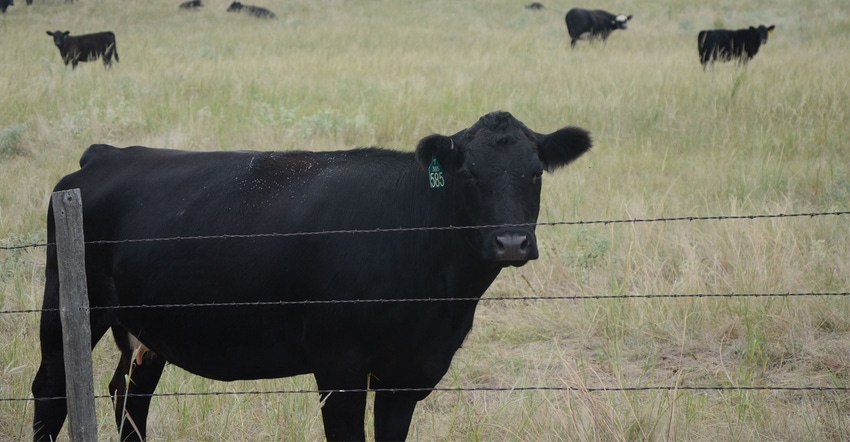September 7, 2018

Finding ways to monitor grazing lands may be one of the most important steps to improving it. Grazing land specialists at the Nebraska Grazing Conference told ranchers the first step is setting a baseline to help them determine where they want to go from there.
Jeff Nichols has worked with private landowners for over 25 years. He helps them monitor grazing land through his position with the Natural Resources Conservation Service in North Platte, Neb. “What people are least likely to adopt as part of a grazing plan is range monitoring,” he said. “Given that, I believe before you can input data into more advanced technologies, you need time on your hands and knees looking at your grazing land to realize what is there.”
Monitoring is a way of measuring and documenting changes to grazing land over time. It is basically a support tool to help producers adjust their management strategies. Nichols said there are two types of monitoring. Short-term monitoring is on a daily basis and helps producers evaluate key plants in deciding when to move to the next paddock or evaluate what’s left at the end of the season. Long-term monitoring evaluates changes in grasslands and ecosystems over time.
Making progress takes time
Beau Mathewson, who ranches with his family near Potter, Neb., told producers that monitoring grazing land is like going to the gym. “If you go to the gym and don’t see progress, then you are either not working hard enough or you are doing something wrong. If you see progress, you keep going,” he said.
Mathewson said his tools for monitoring are a motorcycle he uses to get around to the grazing sites, GPS, a camera with a tripod, a drone and the Grass Snap application. He also relies on NRCS. “I want to make sure what I am reporting and managing is what I am really seeing,” he said. “If they give me the green light, then I think I’ve trained my eye correctly.”
On Mathewson’s ranch, monitoring is one of the deciding factors whether or not they graze that year. “Monitoring can be the difference in plant resilience. It helps you assess and allocate resources for the most sustainable operation possible,” he says. The cover left after grazing is important. “If bare soil is visible, it can result in tiller death. The soil won’t hold moisture as well because it’s too hot,” he said.
Keep long-term records
Mitch Stephenson, who is with University of Nebraska Extension in Scottsbluff, says long-term grazing records are important to help producers make decisions into the future. “You can look at how hard the pasture was grazed from year to year,” he said.
“It’s hard to set good goals for over a long period of time, Nichols said. “I would recommend making specific goals and writing them down because they will change over time. Also, set a time frame to get those goals accomplished. Make them realistic and have a baseline for what the production potential is over time. Tie them back to something using the ecological site description. Identify where you are at in reference to plant communities.”
Mathewson said when they started monitoring rangeland, they managed for the things they could change, starting small and watching for progress. Over the years, they have added pipeline and fencing, working with NRCS to see where it should be built. “One thing that is nice about pipeline is you can put it exactly where you want to. But it takes a long time to put in pipeline and fence. It is not a yearly success story; it may take more than five years,” he said.
PastureMap app
Christine Su is the CEO of PastureMap, an app that helps producers map their pastures, herds and equipment. PastureMap can record past and future herd moves, record pasture inventories, and visually track herd weights, which helps ranchers improve their herd performance with weights tied to grazing records.
With many different apps and ways of monitoring grazing land, producers have to decide which method is most suited to their needs.
Su said producers should use apps like PastureMap as a tool in their toolbox, but it is still important they take the time to go out and look at the grazing land themselves, so they can observe what is happening to it, and if the ecosystem is headed in the direction they want it to go. Then they can set optimal recovery periods based on certain pastures. “PastureMap enables humans to look at the landscape and determine how to change it, and possibly get more out of it,” she said.
The app can also help producers plan out future grazing moves, or consider breaking out different conservation or wildlife priorities. “It helps producers make decisions more quickly. They can get ahead of things like rainfall and drought. Rainfall totals can be put into the tool,” Su said.
Su sees the app as a way for producers to free up time for themselves and their staff. For instance, it can be used to transect spots in the fence that need to be fixed or something as simple as where the feed wagon was left. “It just helps improve communication,” she said.
Clark writes from Potter, Neb.
About the Author(s)
You May Also Like




